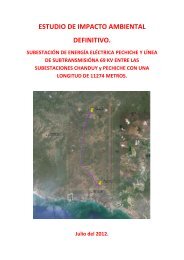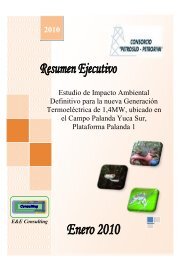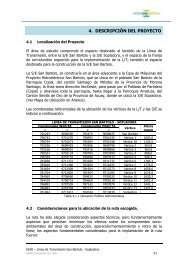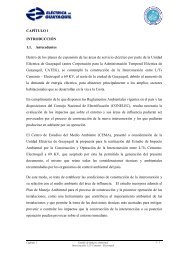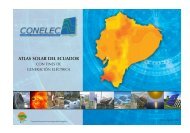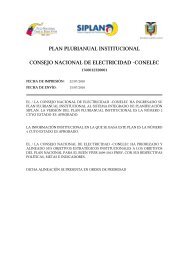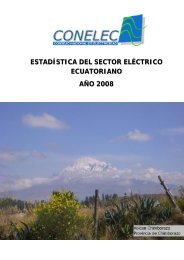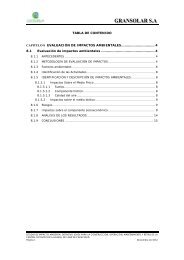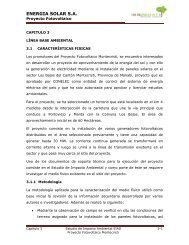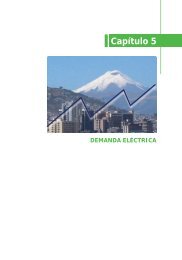estudio de impacto ambiental definitivo del proyecto ... - CONELEC
estudio de impacto ambiental definitivo del proyecto ... - CONELEC
estudio de impacto ambiental definitivo del proyecto ... - CONELEC
- No tags were found...
You also want an ePaper? Increase the reach of your titles
YUMPU automatically turns print PDFs into web optimized ePapers that Google loves.
ESTUDIO DE IMPACTO AMBIENTAL DEFINITIVO DEL PROYECTOFOTOVOLTAICO RANCHO SOLAR CAYAMBE, INCLUYE LINEA DESUBTRASMISIÓN A 69KV ENTRE LA PROYECTA SUBESTACIÓN DE LACENTRAL FOTOVOLTAICA HASTA LA SUBESTACIÓN CAYAMBE DE LAEMPRESA ELECTRICA NORTE S.A.5. LÍNEA BASE AMBIENTAL DEL PROYECTO5.1 MEDIO FÍSICO5.1.1 CARACTERIZACIÓN CLIMÁTICAOBJETIVOSI<strong>de</strong>ntificar los parámetros climáticos y pluviométricos <strong>de</strong> la zona que <strong>de</strong>terminan las condiciones climatológicas <strong>de</strong>lárea <strong>de</strong> influencia <strong>de</strong>l Proyecto y permitan establecer interrelaciones <strong>de</strong> las variables climáticas con otros componentes<strong>ambiental</strong>es.5.1.2 ANÁLISIS Y CARACTERIZACIÓN DE LOS ELEMENTOS DEL CLIMA (DEFINICIÓN DE LA ESTACIÓNBASE)Climatológicamente, el Cantón Cayambe, pertenece a la sub-húmedo temperado, <strong>de</strong> acuerdo al Mapa Bioclimático y Ecológico<strong>de</strong>l Ecuador <strong>de</strong> Cañadas 1983. Los páramos bajos <strong>de</strong> Cayambe se encuentran en una región bioclimática muy húmedo subtemperado,mientras que parte <strong>de</strong> la Reserva Cayambe – Coca se encuentra en una región bioclimática lluvioso Subtemperado.Con la finalidad <strong>de</strong> establecer las características climáticas <strong>de</strong>l área <strong>de</strong> influencia <strong>de</strong>l Proyecto, fue necesario realizar un análisisgeneral <strong>de</strong> los parámetros meteorológicos como temperatura, humedad relativa, heliofanía y/o nubosidad, precipitacionesmedias y extremas, velocidad y dirección <strong>de</strong>l viento, radiación solar, evaporación, entre otras, así como <strong>de</strong> las característicasfísicas <strong>de</strong> la superficie terrestre existente en dicha zona. Conforme lo mencionado para el Proyecto Fotovoltaicos ha establecidocomo base a la Estación Meteorológica Cayambe – M359 (INAMHI).5.1.3 TEMPERATURA DEL ÁREA DE ESTUDIOLa temperatura promedio anual en el Cantón Cayambe es <strong>de</strong> 14 °C. Por encontrarse en dos regiones bioclimáticas conmicroclimas existentes por su biodiversidad y vegetación exuberante, la temperatura varía entre 6 a 16 °C, esto <strong>de</strong>pendiendo laaltura y morfología <strong>de</strong>l terreno.Ilustración 7. Temperatura área <strong>de</strong> <strong>estudio</strong>msnmF34003375300029002860281228002750270026100 2 4 6 8 10 12 14 16 18Temperatura (°C)2610 2700 2750 2800 2812 2860 2900 3000 3375 340065ADEPLAN CIA. LTDADIRECCION: CIUDAD DE LOJACALLE LOURDES Y 24 DE MAYO ESQUINATELF: 2550125www.a<strong>de</strong>plan.com



